
Worldcarblog.com
2023 Honda Civic Type R Review: Fast and Not as Furious-Looking
The verdict
The 2023 Honda Civic Type R capitalizes on the benefits of the mainstream Civic’s new-for-2022 platform and retains all of what made the previous-generation Type R great, while dialing back its aggressive exterior styling.
Versus the competition: The new Type R debuts with more close competitors than its predecessor had. The Hyundai Elantra N, Toyota GR Corolla and Volkswagen Golf R are key rivals, track-focused compact cars that offer manual transmissions and horsepower ratings in the ballpark of the Civic Type R — and all of them are similarly exciting to drive.
American enthusiasts rejoiced when Honda saw fit to bring its top-performance Civic Type R model to the U.S. for the 2017 model year. Prior to that, the Civic Type R was forbidden fruit, offered in select foreign markets from 1997 but never available in North America. When the ‘17 Civic Type R finally launched here, however, its hyper-aggressive exterior styling gave many shoppers pause.
Though it might have looked like a vehicular extra from the first three “Fast and Furious” movies, the 2017-21 Civic Type R’s outlandish, boy-racer looks covered a finely honed track machine with an astutely tuned chassis and smooth, strong turbocharged four-cylinder engine. The Type R offered racetrack-ready performance with a livable character in everyday driving, and even came with a few upscale interior touches that gave it a classier vibe than your everyday Civic.
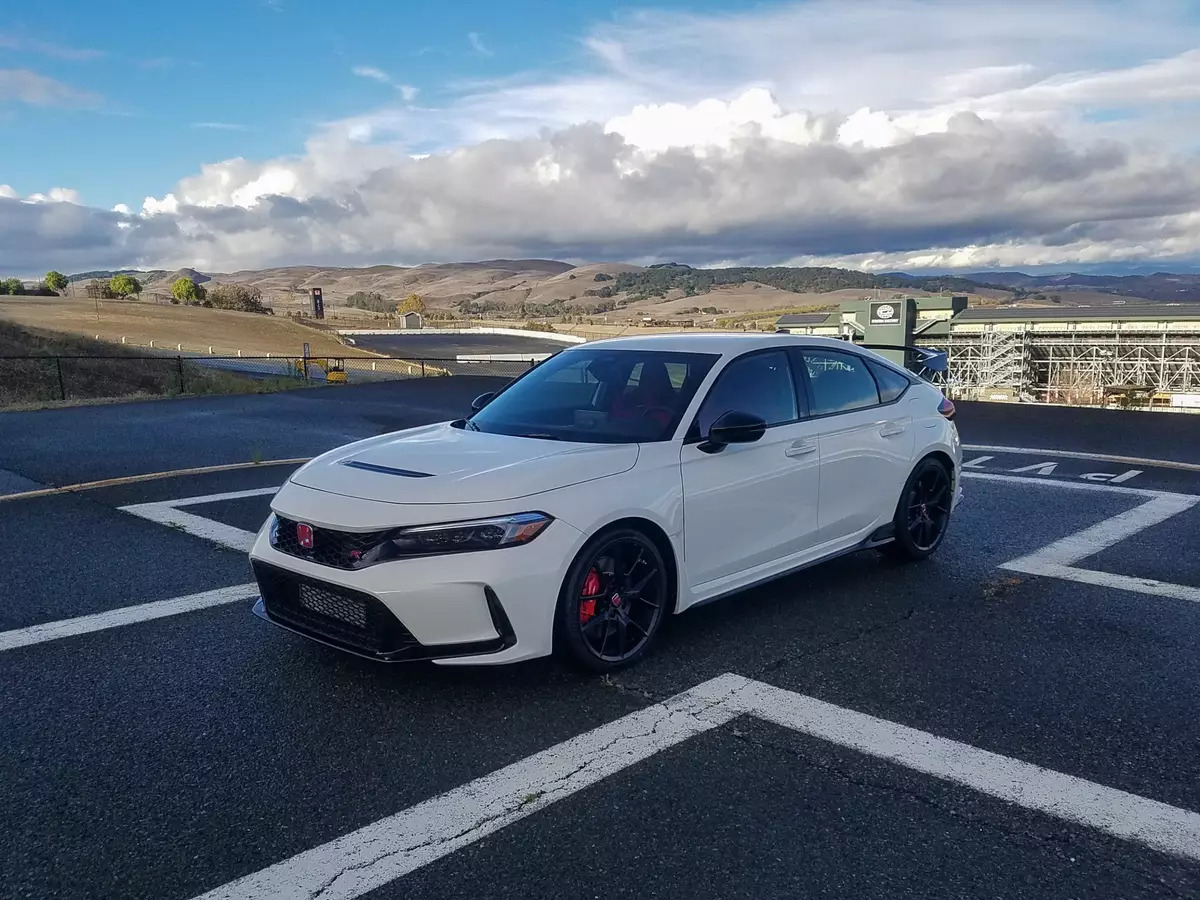
The Type R took a one-year breather when the Civic was redesigned for the 2022 model year, and it returns on the car’s new platform for 2023. The basic concept stays the same: front-wheel drive, a four-door hatchback body style and lots of high-performance hardware. At Honda’s invitation, I drove the new Civic Type R on the road in California’s Napa Valley area and briefly on the track at Sonoma Raceway. (Per our ethics policy, Cars.com pays for its own airfare and lodging when attending such manufacturer-sponsored events.)
Upgrades Under the Hood
Like the previous-gen Civic Type R, the new one is powered by Honda’s K20C1 turbo 2.0-liter four-cylinder, but the engine gets a few noteworthy upgrades. The turbocharger is new, the air intake flow rate has been increased, and a new active-valve exhaust system increases exhaust flow by 13% over the previous-gen Type R. The result is 315 horsepower at 6,500 rpm and 310 pounds-feet of torque from 2,600-4,000 rpm (improvements of 9 hp and 15 pounds-feet over the previous Type R). Engine cooling has also been improved via a larger front bumper opening, larger radiator and larger-diameter cooling fan.
As before, the engine is paired exclusively with a six-speed manual transmission — an automatic is not offered. Honda says the flywheel is 18% lighter than before, reducing rotational inertia, sharpening engine response and enabling quicker engine rev matching from the automatic rev-matching system.

Girded Loins
The basic Civic body structure receives a few rigidity-improving measures for Type R duty. Honda says it used 3.8 times more structural adhesives in critical areas and implemented structural enhancements in various components of the body and chassis architecture.
The car’s track is 1 inch wider in front and 0.75 inch wider in back than the previous Type R, and the wheels and tires are a bit wider, as well: lightweight 19-inch alloys fitted with unique Michelin Pilot Sport 4S P265/30R19 tires. (Honda Performance 19-inch forged-alloy wheels and track-focused Michelin Pilot Sport Cup 2 tires are available accessories.) The brakes have been upgraded to Brembo 13.8-inch two-piece rotors with four-piston calipers up front and 12-inch rotors in back. Honda says brake cooling has been improved through increased airflow through the front end.
Handling-focused suspension revisions include stiffer spring rates and larger, stiffer stabilizer bars front and rear. An adaptive suspension system automatically adjusts damping based on driving conditions and drive-mode selection.
On Track and Street
Uncharacteristically rainy weather in California on the day of the press event meant we were unable to push the Type R close to its limits at Sonoma Raceway, but we nonetheless got a decent sampling of its capabilities. Though wet pavement occasionally showcased the traction limitations of pushing 315 hp through the front wheels, the Type R is a ferociously capable cornerer and tenacious performer all around that remains livable in street driving despite its track-focused enhancements.
The Type R has four driver-selectable modes (Comfort, Sport, Plus R and a customizable Individual setting) that alter engine response, steering assist, suspension damping, engine sound, rev-match speed and the digital gauge cluster. In Comfort mode, the suspension is acceptably compliant over rough pavement and most bumps. The Plus R mode is best reserved for racetracks and pristine roads; it significantly stiffens the suspension and amplifies the car’s snarky character. In any driving mode, the brakes supply impressive, confidence-inspiring stopping power.
High-performance turbocharged four-cylinders aren’t typically low-end torque monsters — they need higher engine rpm for the turbocharger to spool up and provide boost for truly strong acceleration. By these standards, the Type R does exceptionally well: It pulls smoothly and strongly from relatively low rpm, and the turbo’s boost arrives in a steady, predictable-but-still-exciting fashion, accompanied by a raspy snarl from the exhaust that’s music to enthusiast ears.
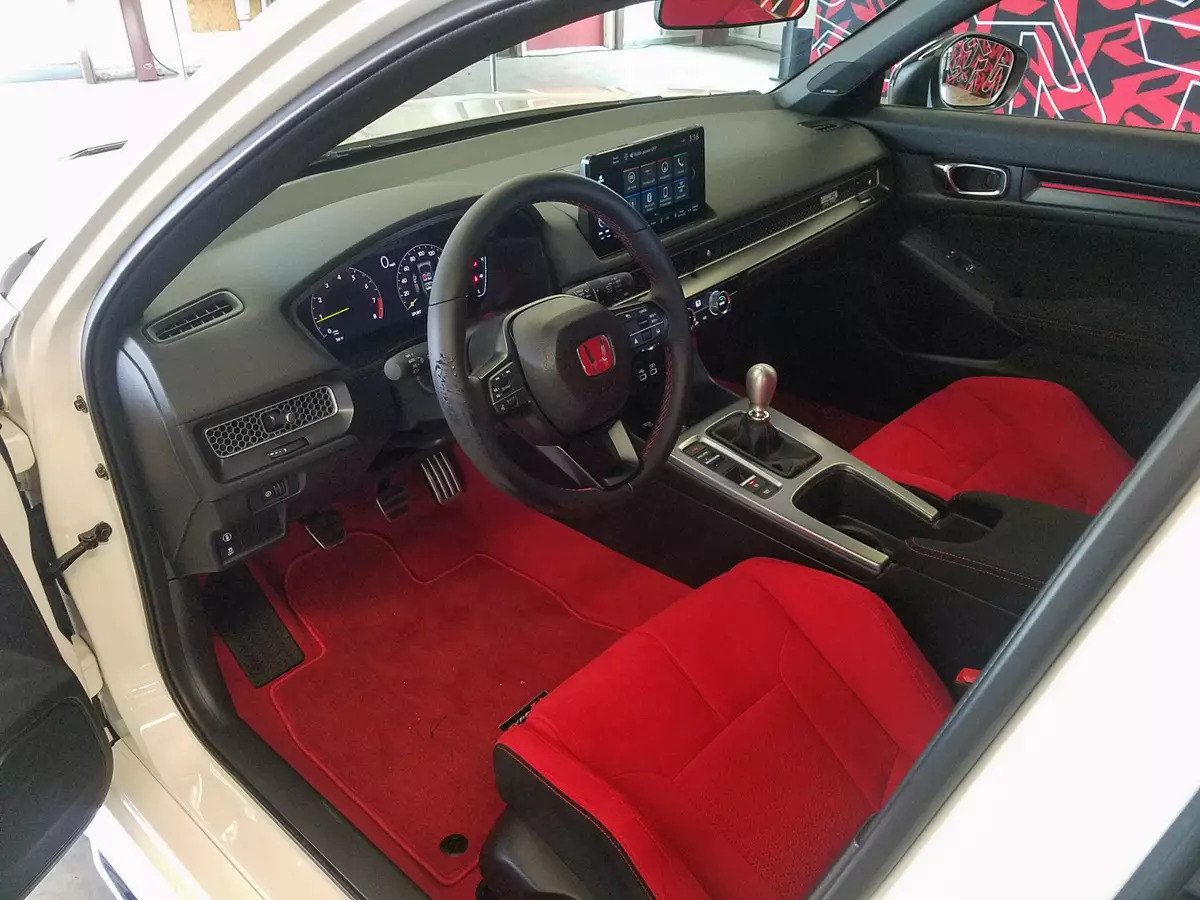
The manual transmission is also a delight. It’s agreeable and easy to use thanks to a smooth, progressive clutch pedal and an excellent short-throw shifter with a precise, mechanical action. However, I wasn’t thrilled with the egg-shaped shift knob — the more traditional ball-shaped knob of the previous Type R felt more natural in my hand and easier to grip firmly. Honda offers an accessory leather-wrapped shift knob; I might opt for that instead.
Selecting the Plus R drive mode switches the digital gauge panel from traditional analog-style tachometer and speedometer dials to a racecar-style display with a horizontal tach and a prominent gear-position readout. There are also separate shift-indicator lights above the gauge cluster that illuminate progressively as the engine nears its redline. When it’s time to downshift, the rev-matching system automatically blips the throttle for smooth gear changes. (You can turn this feature off if you’re better at heel-and-toe shifting than I am.)
Speaking of performance displays, the Type R’s updated LogR Performance Datalogger system should delight the track-rat crowd. It’s now a stand-alone app (no smartphone is required) and boasts a plethora of digital gauges, including a G-meter display, engine oil temperature and pressure, intake air temperature, turbo boost pressure, steering angle and accelerator opening angle, to name a few. Also included are a stopwatch for recording lap times, integrated track maps for notable race courses across the country and even an “Auto Score” function that generates a driver score based on the smoothness of their acceleration, braking and steering.
Seeing Red Inside
The Type R’s interior gets several performance-themed trim touches, such as red carpeting, contrast stitching and seat belts; faux suede upholstery on the front seats, door panel inserts and center console armrest; aluminum pedals; and a serial-numbered Type R badge on the dash. The main upgrades are the aforementioned short-throw shifter and a pair of sport front seats with pronounced bolsters and dual belt pass-throughs (for aftermarket racing-style harnesses). The previous-gen Type R’s front seats struck a near-ideal balance between snugness and support for aggressive driving on a racetrack and livable comfort for everyday driving and longer trips. The new seats offer a similar mix of comfort and support, though they’re a bit tighter on my backside than I remember the previous Type R’s seats being.
Those pronounced seat bolsters complicate entry and exit a bit since you can’t slide over them easily. The Civic also has a fairly low driving position for a mainstream compact car. This enhances the high-performance feel of the Type R but necessitates a deeper drop into the seats and a higher climb out than you might expect. The seats don’t offer any lumbar adjustments or heating, and the integrated head restraints aren’t adjustable.
Compare vehicles
Compared to the front seats, the Type R’s rear seats feel very much like an afterthought. Not only do they not get the same flashy red upholstery — they’re covered in plain old black cloth, jazzed up only by the red seat belts and a bit of red contrast stitching — they make do with a plastic dual cupholder insert plunked right in the middle of the bottom cushion. There’s no flip-down rear armrest and no provision for a middle rear-seat passenger.
Practical Considerations
One of the nice things about the Civic Type R is simply that it’s a Honda Civic hatchback — a spacious, practical compact car that boasts a rear seat that can comfortably accommodate average-sized adult passengers and a versatile cargo area that offers space on par with (or more than) many subcompact SUVs.
The Type R also benefits from the improvements of the new-for-2022 Civic. The thinner, more upright windshield pillars and door-mounted side mirrors are visibility aids especially beneficial in high-performance driving. The standard Bose premium audio system sounds great, the Honda Sensing suite of active-safety features gets welcome updates including a new camera that can see farther and has a wider field of view, and the Type R now comes with blind spot warning and traffic sign recognition.
Boy Racer Begone (Mostly)
Honda has dialed back on the outlandish styling of the old Type R, but there’s still plenty to differentiate it from an Si or other mainstream Civic. In fact, other than the front doors, roof and hatchback liftgate, the Type R’s body panels and add-on components are unique, aimed at improving aerodynamic and cooling performance or increasing downforce for better high-speed stability.
The gaping front end sports a honeycomb-pattern grille and ducts for brake cooling. The hood is made of aluminum for weight savings, and it has a large vent for dissipating radiator heat and minimizing airflow resistance. Wider, flared front and rear fenders cover the wider tires. Unlike the previous-gen Type R, which wore separate rear fender flares that looked a bit tacked on, the new Type R has rear fenders with integrated flares. The rear doors are unique to the Type R, as well, flaring out to meet the wider rear fenders for a smoother, more cohesive look that Honda says also aids aerodynamics.
As with the previous Type R, a large rear wing is part of the package. It has aluminum stanchions and, thankfully, is positioned so that it doesn’t interfere with the view out the rear window — it sits just below the top of the window opening, above the driver’s sightline. A carbon-fiber wing is available as an accessory option.
The Bottom Line
Like its predecessor, the new Civic Type R is essentially an all-in, mono-spec offering — it comes in a single well-equipped trim level with everything standard. The Civic Type R is arriving at Honda dealers now, with a starting price of $43,990 (all prices include destination). The only factory option is exterior color, and there are just five of those: Crystal Black Pearl and Rallye Red are no extra cost; Boost Blue Pearl, Championship White and Sonic Gray Pearl are $395.
That’s still a serious jump over the $38,910 sticker of the regular-edition 2021 Type R, but it’s comparable to a few of the Type R’s key competitors: The redesigned-for-2022 Volkswagen Golf R, starts at $45,385, and the new-for-2023 Toyota GR Corolla starts at $43,995 in comparably equipped Circuit Edition trim. Both of those rivals have all-wheel drive, which the Type R doesn’t offer, and the GR Corolla also comes as a pared-down Core model that starts at a more accessible $36,995. The delightful Hyundai Elantra N is more affordable still and starts at $33,745. Its 276-hp, turbo 2.0-liter four-cylinder gives up 39 hp to the Type R, but the N offers a similar roster of track-focused enhancements that make it a hoot to drive as well.
Given the realities of today’s new-car marketplace, where trucks and SUVs are the dominant body style, it’s a happy development that performance enthusiasts have this many solid hot-rod compacts from which to choose — and all of them are invigorating to drive and cost less than the current average transaction price of a new vehicle.
Source: cars.com
Audi got a new logo - modernization of tradition
The four rings, of course, remain, but are now integrated into the black background.
In the auto industry, the fashion of changing logos has taken hold, and even Audi has not resisted this trend.
Instead of 3D effects, which were used by almost all car manufacturers for their emblems, today 2D simplicity is at the price.
Audi is another brand that has embraced this trend, introducing a new 2D mark for its vehicles and brand-wide branding.
The four rings remain, but are now integrated into the black background.
The idea of a 2D Audi logo dates back to 2016, but it didn't really take off until 2020, when the German automaker began rethinking its corporate identity, deciding that it wanted the four rings to look the same everywhere.
The first new model to receive a new emblem on the front fascia is the recently presented Audi Q8 e-tron.
And finally, a little reminder. Until now, the Audi logo looked like this:
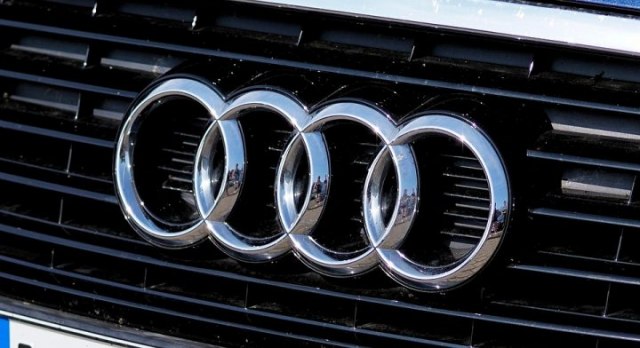
You won't believe how much Tesla makes more than Toyota per car sold
The sales margins enjoyed by the American electric car manufacturer Tesla are just a dream for traditional manufacturers. Tesla as a company started slowly, but for years it has been proving that it is possible to profit from electric vehicles.
The best example of Tesla's sales margins is their comparison with one of the world's largest car manufacturers - the Japanese Toyota. According to the latest financial results, Tesla earns as much as eight times more per car sold than the Japanese icon of the automotive industry.
Toyota has been at the top in terms of the number of cars sold for decades, and it can definitely be said that the Japanese company has the knowledge and skill to create successful products that bring profit. What's more, while Toyota hasn't turned to all-electric cars as quickly as many manufacturers, most of their lineup is hybrid-powered, and some of them are available as plug-in hybrids.
On the other hand, Tesla still produces only four electric models (5 if the Semi truck is also counted). That's why it's interesting how Tesla earns eight times more per car sold than Toyota. Although the math is not that precise, the fact that Tesla makes much more per unit cannot be disputed.
During the third quarter of this year, the American company reported $3.29 billion in profit, while Toyota's profit for the same period was $3.15 billion. During those three months, Toyota delivered eight times more vehicles to customers than Tesla globally.
The new Euro 7 standard has been introduced, here's what it means for drivers
At the end of last week, the European Commission proposed a regulation with new rules for reducing emissions from motor vehicles called Euro 7, which for the first time regulate the emissions of particles and microplastics that arise from the use of tires and brakes.
The new Euro 7 norm will replace the previous one, which has separate rules for emissions from cars and light commercial vehicles (Euro 6), and for trucks and buses (Euro VI).
The new Euro 7 standard introduces a single set of rules for limiting emissions for all motor vehicles. The new standard sets the same emission limits for all vehicles regardless of whether the vehicle uses gasoline, diesel, electric propulsion or alternative fuels. The draft regulation includes emissions from exhaust pipes, as well as brakes and tires.
This means that producers, and therefore buyers, will have a higher cost when producing, that is, buying, above all, diesel cars, which will now have to reach a slightly lower level of exhaust gases of gasoline cars.
All new cars on the European Union market will have to have zero CO2 emissions from 2035, but more than 20 percent of cars and vans, as well as more than half of heavy vehicles in 2050, are expected to still emit gases from their tailpipes.
Unlike internal combustion engines, electric vehicles have no exhaust fumes, but they still cause pollution from brakes and microplastics from tires. The new rules set additional limits on particulate emissions from brakes and microplastics from tires, and they will apply to all vehicles, even electric ones.
"We are the first in the world to regulate emissions from tires and brakes," said European Internal Market Commissioner Thierry Breton. The new rules also set emission limits for previously unregulated pollutants, such as nitrogen oxide emissions from heavy-duty vehicles.
As N1 writes, the European Commission believes that emissions of solid particles, which are caused by the use of brakes, will decrease by 27 percent by 2035. The plan is to reduce the emission of nitrogen oxides by 35 percent for passenger cars and vans compared to Euro 6, and by 56 percent for trucks and buses compared to the Euro VI standard.
"We cannot accept a society where air pollution is the cause of more than 300,000 premature deaths in the EU annually. The new rules will help us breathe safer and help the automotive sector become greener and more resilient," said Margrethe Vestager, Vice President of the European Commission.
Schumacher's Ferrari sold - "only" 13 million euros
The Ferrari car with which Michael Schumacher won the Formula 1 World Championship in 2003 was sold at auction for 13.1 million euros.
The auction house "Sotheby's" in Geneva issued a notice that during the auction, which lasted about forty minutes, the final bid was received by telephone.
Five years ago, another "Ferrari" driven by Schumacher in the 2001 championship was sold for 7.5 million dollars, so the previous record was broken at this auction, according to RTS.
The auction house predicted that the maximum price would be around 9.5 million euros, so this sale exceeded all expectations. It is a "Ferrari" F2003-GA, chassis 229, the vehicle with which Schumacher won his sixth world title and the penultimate of his remarkable career. With this car, the German champion won five victories in nine races, including the Italian Grand Prix in Monza.
Ferrari has been named one of the best companies in Italy for 2022 in terms of working conditions, as well as one of the most valuable Italian brands. The identity of the person who bought the Ferrari is unknown, but well-informed sources assume that it is a well-known European collector.
The 2003 Ferrari F2003-GA was designed by Rory Byrne and Ross Brown. It has an engine of 930 horses and reaches 19,000 revolutions per minute. In that year 2003, Michael Schumacher won six victories – in San Marino, Spain, Austria, Canada, Italy and the United States.
New Fiat e-Doblo 2022 van audit
Most recent Doblo gets an all-electric rendition that is exceptionally natural
Decision
The Fiat e-Doblo is a lot of the Italian company's minor departure from a generally existing topic. Nonetheless, since it depends on what's as of now the little electric van class pioneer, that is not something terrible the least bit. Like its kin, the e-Doblo is fundamental as standard, however it's convenient that the high level tech is presented in esteem driven packs that group the very best pieces together. Another deal that could entice purchasers Fiat's way is its 555 proposition, which offers five years of guarantee, overhauling and emergency aides cover in a solitary reasonable bundle.
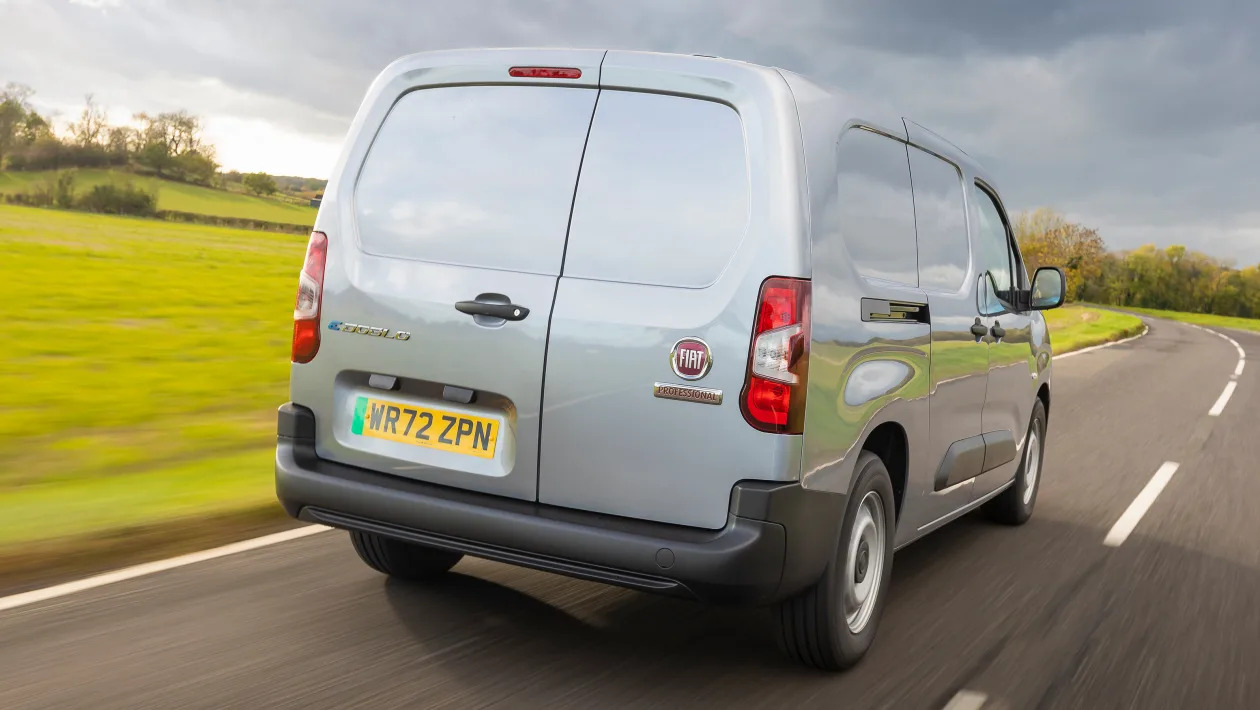
The van world is inundated with joint endeavors, as organizations attempt to expand benefits by utilizing similar innovation on various models, and the Fiat Doblo is positively a result of that interaction. The last Doblo was created in a joint endeavor with General Engines close by the Vauxhall Combo. Yet, when GM offloaded Vauxhall to public service announcement Peugeot Citroen, that association reached a conclusion. Nonetheless, now that public service announcement and Fiat are two prongs of the Stellantis Gathering, the Doblo by and by shares much with the Combo, as well as the Citroen Berlingo, Peugeot Accomplice and Toyota Proace City. That additionally implies there's currently an all-electric e-Doblo as a feature of the new Doblo line-up.
Confounded? You needn't bother with to be, on the grounds that basically these vans are indistinguishable, save for an alternate front end plan from the main edge of the hood forward, while there are minor varieties concerning trim levels, choices and aftersales back-up.
Remotely, the e-Doblo has a smooth nose and Fiat's most recent corporate marking, however other insightful seems to be indistinguishable from the Citroen e-Berlingo - even the headlights are something similar. That is not something terrible, on the grounds that the one-box shape implies there's bunches of room inside. Fiat offers the e-Doblo in L1, L2 and Team Van body styles, and when you add the through-stacking bulkhead (one more choice that is presented on all the e-Doblo's partners), there really depends on 4.4 cubic meters of room in the L2 variant.
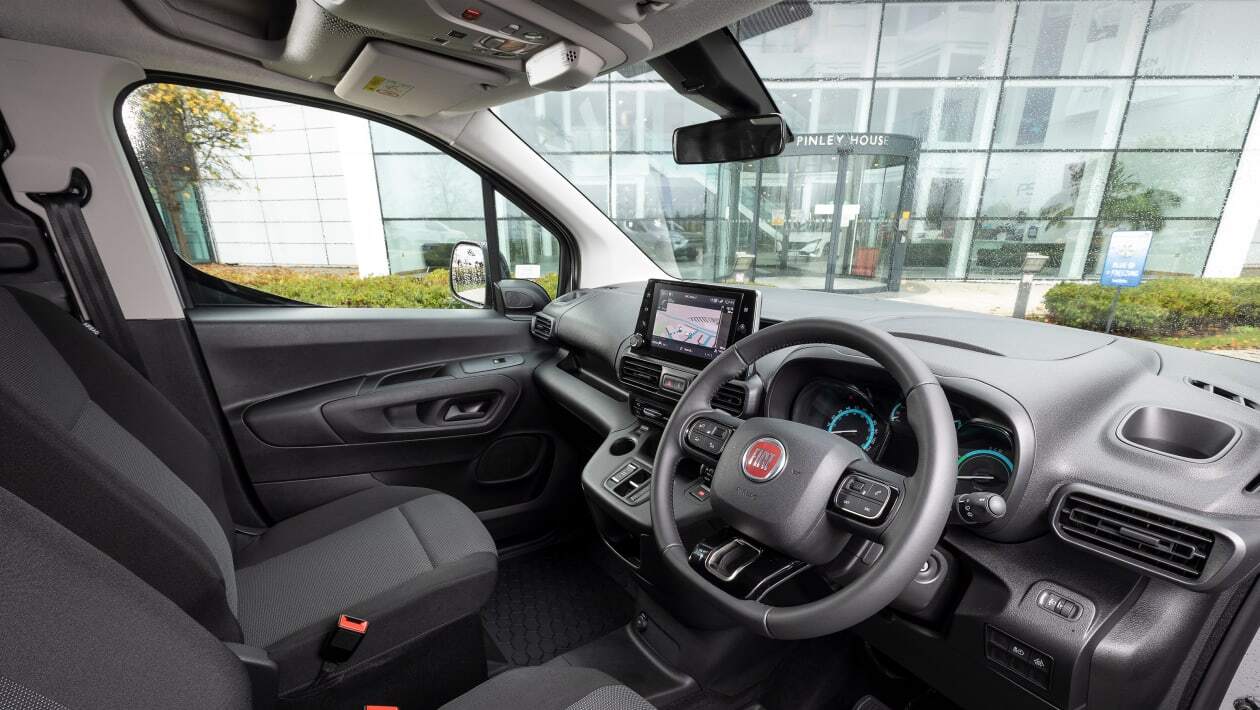
Payload loads of up to 800kg are on offer, while the e-Doblo can tow as much as one ton, as well. That is quite close what's accessible with the standard Doblo, however with the additional advantage of zero-outflows driving.
There's a 50kWh battery mounted under the freight floor (it doesn't affect freight volume), while a 100kW charging framework implies that the battery can be recharged from a high-voltage DC source from 0-80 percent in 30 minutes. This gives the e-Doblo a greatest cited scope of 175 miles, albeit this will differ as per surrounding temperature and payload.
While Fiat cites a power result of 134bhp, this is just presented in Power mode, which is one of three drive settings that are accessible. In the default Ordinary setting, there's 108bhp on draft, however this is a lot for regular driving. As a matter of fact, pick Power mode, and the choke feels excessively anxious to answer, meaning you need to in like manner change your driving style. It likewise thumps around 10 miles of reach off the battery.
At the furthest edge of the range, Eco mode stakes power back, as far as possible your maximum velocity and furthermore slices the cooling to paw back approximately 10 miles of reach. In any case, the van is so dreary in this mode that you wind up putting in to speed up more effort to compensate for the absence of reaction. Eco mode is just truly of purpose in the event that you're getting coming up short on charge and need the additional reach - think about it like a save gas tank on a petroleum motor.
Out and about, the e-Doblo is completely calm and peaceful, and is unquestionably significantly simpler to drive than a regular petroleum or diesel van, because of its single-speed transmission. Absolutely stick it in drive, and away you go. There is a 'B' mode for the transmission that supports energy recovery when you lift off the choke - comparative in solidarity to a manual model easing back in a low stuff - however we'd just suggest utilizing this at metropolitan rates, since it can gain for jerky headway while cruising on double carriageways, for instance.
In all actuality, and like the wide range of various Stellantis little electric vans, the e-Doblo is at its best at low paces in and out of town, where its mobility, sharp speed increase and usability make its mark. Hold the speed down, and you'll probably come near the real reach assessed by the excursion PC.
The e-Doblo is fundamental as standard, yet Fiat offers various packs that upgrade the spec list. Among the highlights on offer are a long-lasting back view camera show instead of a mirror, while the vulnerable side camera could likewise prove to be handy. There's touchscreen route, Apple CarPlay and Android Auto, and unit, for example, the Solace Drive Help Pack adds path observing, sluggishness alarm and speed limit acknowledgment.
One feature of the e-Doblo is the accessibility of Fiat Expert's 555 bundle. This discretionary reseller's exchange pack adds a five-year guarantee, in addition to overhauling and emergency aides cover for a similar period. It very well may be sufficient to swing purchasers Fiat's far over its kin rivals.
Toyota confirmed: The new Prius will arrive on November 16!
The fifth generation of Toyota's pioneer of hybrid technology.
Toyota has finally confirmed that the mysterious hybrid model, which was recently announced by the company, is indeed the new generation Prius, whose online premiere will be held on November 16.
The new teaser reveals some design details of the model, including aggressive headlights that are somewhat similar to the recently revealed Toyota Crown.
The sharp lines of the LED headlights and the dynamic lines on the hood emphasize the Toyota emblem on the front fascia.
The profile is sleeker than previous generations of Prius, while maintaining a focus on aerodynamics and 5-door body style.
Another detail that we see in the teaser more clearly than before is the emphasis on the rear sides of the "tail" of the vehicle.
Toyota describes the new Prius as "Hybrid Reborn". This model has always been a pioneer in terms of hybrid technology, so we expect Toyota engineers to further improve the efficiency of the powertrain, as well as driving dynamics and safety technology.
Reports from Japan reveal that the model will be based on the new E3 mechanical platform, using components from the proven TNGA-C base and architecture used exclusively for the bZ series battery electric vehicles.
In addition to the "classic" gasoline-electric hybrid, which will most likely be offered from the beginning, there have been rumors of a hydrogen-electric hybrid coming in 2025.
The latter could be the first production model to use Toyota's hydrogen SUS engine although nothing has been confirmed by the manufacturer at this time.
More details about the new Prius will be revealed next week, and we wouldn't be surprised if Toyota continues the teaser campaign through its social media channels over the next few days.

















